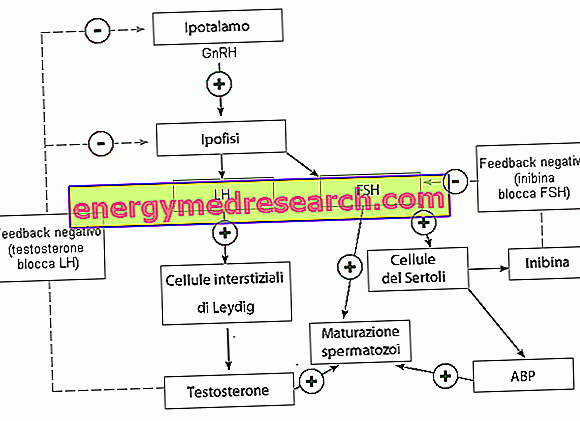Multiple sclerosis
Multiple sclerosis (MS) is a disease that damages the myelin sheaths of neurons located in the central nervous system. The name "sclerosis" refers to the relative scars visible in the brain and spinal cord.

It appears more frequently between the ages of 20 and 50 and is twice as common in women than in men.
Multiple sclerosis can manifest itself in an isolated (recurrent) manner or worsen over time (progressive).
Between one attack and another the symptoms may disappear completely, but the neurological lesions are definitive.
The causes of multiple sclerosis are not certain and it is probable that it is an autoimmune disease (evident from the activation of T cells) or caused by the malfunctioning of the myelin producing cells.
The predisposing factors for MS are genetic and environmental (for example, a viral infection).
Diagnosis is made on the basis of clinical signs, symptoms and laboratory tests.
There is no definitive cure. The available treatments improve recovery after attacks and facilitate prevention.
Drugs can have very important side effects, while motor therapy tends to preserve functional capacity.
Life expectancy in multiple sclerosis patients is 5-10 years lower than in the healthy population.
In 2013, around 2.3 million people were affected by MS and 20, 000 died against 12, 000 in 1990 (the statistics suggest a significant increase in diagnosed cases).
Diet
Diet appears to be partially implicated in the onset of multiple sclerosis.
The evidence on the relationship between MS and nutrition varies according to the nutrient under consideration; sometimes they are scarce and unconvincing, while in others they seem more evident and objective.
Since the trials supporting nutritional treatments continue to be weak, the diet can be considered an alternative or at most complementary therapy system.
Today more than 50% of people with multiple sclerosis also rely on alternative medicine (despite the percentage varying according to the method of classification of protocols).
Of the many solutions, dietary supplementation, certain dietary regimens, hyperbaric oxygen therapy, self-infection with ankylosomes, reflexology, yoga and acupuncture are the most accredited.
As for the dietary field, they find more use:
- Supplement with vitamin D (calciferol).
- Antioxidant supplement.
- Supplement with essential polyunsaturated fatty acids (PUFA).
Vitamin D and Multiple Sclerosis supplements
Vitamin D is a fat-soluble molecule with various metabolic functions (bone metabolism, immune system, etc.).
It can be taken with food or synthesized in the skin starting from cholesterol and in the presence of UV rays.
High levels of vitamin D3 (colecalciferol) are statistically associated with:
- Less risk of contracting multiple sclerosis.
- Lower number of relapses.
- Smaller and sparse central nervous system scars.
- Greater conservation of motor function.
In contrast, a modest plasma concentration of vitamin D3:
- Increases the overall danger of the disease.
- The severity of the damage caused increases.
This could be due to the immuno-modulating effect of the vitamin on perennially active T cells.
The study by Hayes CE. " Vitamin D: a natural inhibitor of multiple sclerosis " has shown that by supplementing with 10ng / ml of vitamin D3 per day a reduction in the risk of injury by 15% and relapse of 32% can be achieved.
The foods richest in cholecalciferol are: egg yolk, fishery products, cod liver and oil, etc.
Antioxidant and Multiple Sclerosis Supplement
Myelinated degeneration of nervous tissue has an inflammatory and oxidative etiology.
It is scientifically demonstrated that oxidation and lipid peroxidation in myelin tissue play a fundamental role in the etiology of multiple sclerosis.
On the other hand, it has not yet been possible to correlate the reduction of general oxidative stress with an improvement in the pathological condition of MS.
The elements used in antioxidant experimentation are of nutritional origin, although it may be useful to carry out measurements concerning the concentration and efficacy of the antioxidants produced in the organism itself.
The effect on multiple sclerosis of food supplementation with:
- Selenium: it is mainly contained in: meat, peach products, egg yolk, milk and derivatives, fortified foods (potatoes, etc.).
- Vitamin A or retinol equivalent: they are contained in vegetables and red or orange fruits (apricots, peppers, melons, peaches, carrots, squash, tomatoes, etc.); they are also present in shellfish and milk.
- Vitamin C or ascorbic acid: it is contained above all in the acidulous fruit and in the raw vegetables. In particular: peppers, lemon, orange, grapefruit, mandarancio, parsley, kiwi, lettuce, apple, chicory, cabbage, broccoli etc.
- Vitamin E or tocopherols (or tocotrienols): it is available in the lipid portion of many seeds and related oils (wheat germ, maize germ, sesame, etc.).
The results have been controversial.
While protecting from oxidation, these nutritional principles seem to activate the T cells and macrophages implicated in the etiology of multiple sclerosis.
The safety of their use is yet to be defined.
Importance of PUFA and Swank Diet
PUFA
Essential polyunsaturated fatty acids (PUFAs) are lipid molecules that the body is unable to synthesize independently. At the right doses and in the correct proportions they all have a beneficial effect on cholesterolemia, blood sugar levels, high blood pressure and cardiovascular risk in general.
PUFA can be classified into two types:
- Omega 3 (especially alpha-linolenic acid, eicosapentaenoic acid and docosahexaenoic acid): precursors of the anti-inflammatory molecules par excellence.
- Omega 6 (linoleic acid, gamma linoleic acid, diomogamma linolenic acid and arachidonic acid): also involved in the synthesis of PRO-inflammatory molecules.
In particular, arachidonic acid is the omega 6 polyunsaturated which has the most inflammatory role.
GOOD FATS AND BAD FATS
As anticipated, essential polyunsaturated fatty acids perform many beneficial functions for the body
Most of these are in opposition to the role of the so-called "bad fats", that is: cholesterol, saturated fatty acids and hydrogenated fatty acids, the latter above all in trans conformation.
We specify that the "bad fats" are defined as such because an EXCESS in the diet can cause some metabolic discomforts. Moreover, it has been shown that a diet too rich in these molecules can negatively affect the maintenance of cognitive abilities during old age.
This does not mean that they are useless or completely harmful. They too play an important role in maintaining nerve health because they structure a large part of myelin.
MYELIN
Myelin is a very fatty substance (70% lipids in the dry substance) and contains above all:
- Cholesterol.
- Phospholipids.
- Galactolipids.
The proportion is 4: 3: 2.
Phospholipids and galactolipids are composite of:
- 75% from SATURIAN fatty acids (50% stearic or octadecanoic and 25% lignocerico or tetracosanoico).
- 25% from monounsaturated (24: 1 nevroic acid or cis-15-tetracosenoico).
It can be deduced that saturated fats and cholesterol are not to be considered totally harmful nutrients, since they structure most of the myelin guanine.
However, we must not forget that:
- The organism is able to produce them independently.
- Any excess can prove harmful to:
- Cholesterolemia and atherosclerotic risk.
- Nerve efficiency, especially during aging.
Their intake with food should only be complementary or even marginal to endogenous synthesis.
SWAK DIET
With the advent of the Second World War, even in the USA there was a significant decline in the consumption of food of animal origin.
During this period, neurology head physician Roy Swank found a 200-250% reduction in multiple sclerosis cases.
Sensing a nutritional correlation, he subsequently experimented with a nutritional regime almost devoid of meat, fish, eggs and dairy products.
Food therapy (Swank Diet) envisaged maintaining fats at 20% of total energy, or about 5-10% less than the norm.
Roy Swank experienced a significant improvement in symptoms and a reduction in relapses in 95% of cases of multiple sclerosis.
A potential therapeutic role of a diet cyclically poor in animal proteins (and calories) was also highlighted by preliminary studies on the fasting diet.
PUFA SOURCES
The most biologically active omega-3 (DHA and EPA) are mainly found in fishery products, in particular in blue fish and extraction oils (Sardinian, mackerel, bonito, alaccia, herring, alletterato, tuna belly, needlefish, algae, cod liver oil, seaweed oil, krill oil, etc.).
The less active omega 3 (ALA) are contained in some seeds and related extraction oils: soy, linseed, kiwi seeds, grape seeds, etc.
The omega 6 are contained above all in certain seeds, part of them or extraction oils. In particular: sunflower, wheat germ, sesame, almost all dried fruit, corn germ, etc.
NORMAL RECOMMENDED DOSES
To maintain a metabolic balance, the research institutions recommend taking the essential polyunsaturated fatty acids in the omega 3 / omega 6 = 1: 4 ratio and in a total quantity of about 2.5g / day (0.5g omega 3 and 2.0g omega 6).
The intake of saturated or hydrogenated fats should be equal to that of PUFAs and dietary cholesterol should remain below 200-300mg / day.
CONCLUSION
Ultimately, it could be useful to reduce the amount of total fat in multiple sclerosis.
Furthermore, it is advisable to prefer the omega 3 fraction for the production of anti-inflammatory eicosanoids, to the detriment of the omega-6 precursors of inflammatory eicosanoids and bad fats (but without eliminating them completely).
Gout and Multiple Sclerosis
There is a statistical correlation between uricemia, gout and multiple sclerosis.
It seems that gout is rarer in patients with multiple sclerosis than in the general population.
The detection of uric acid in the blood seems to confirm this hypothesis; levels of this metabolite are lower in people with multiple sclerosis than in healthy ones.
It is conceivable that uric acid plays a protective role from multiple sclerosis, although the real importance and mechanism of action are still the subject of studies.



